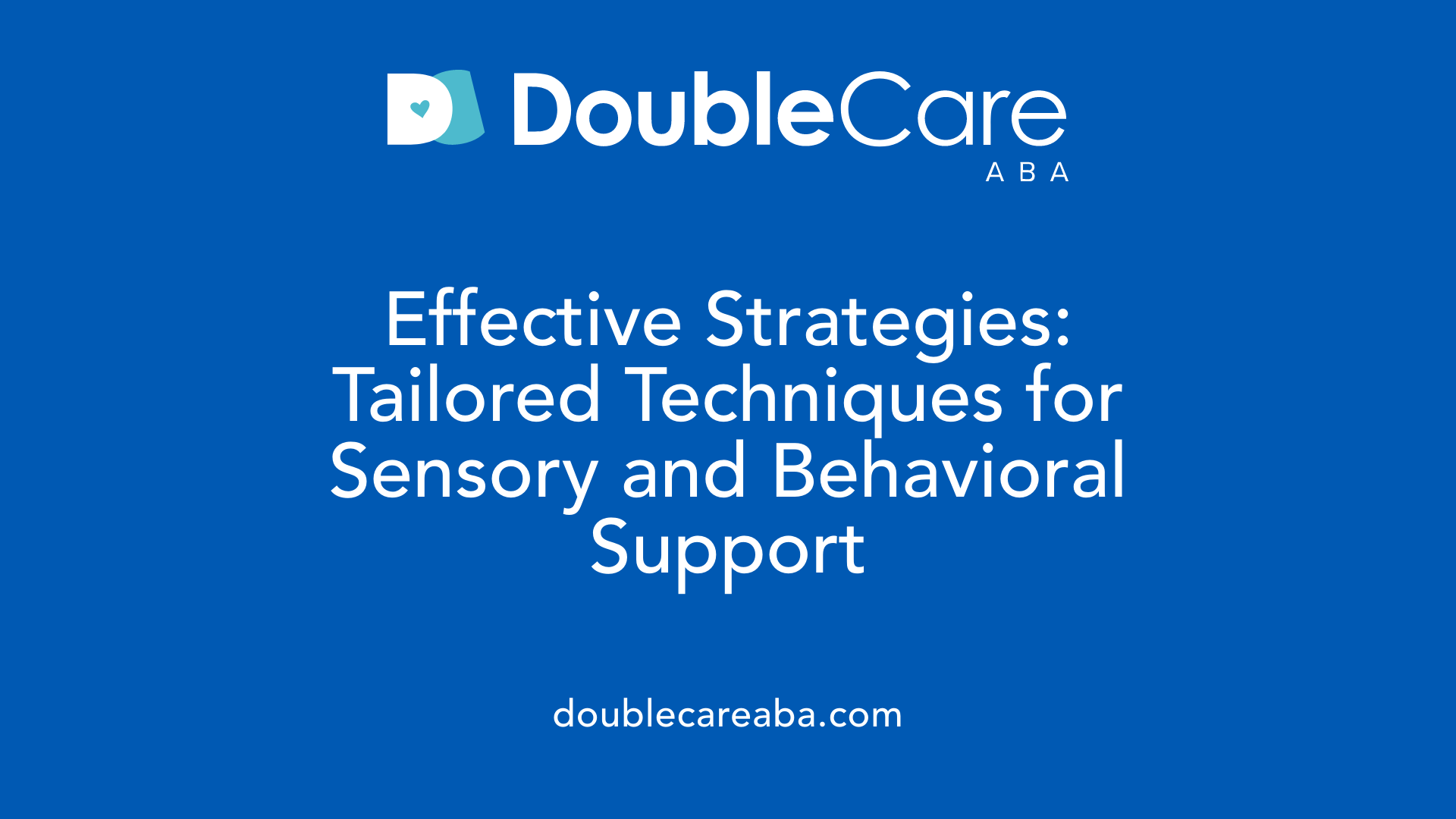Strategies for Calming Sensory Overload
Understanding and Managing Sensory Overload in Autism Spectrum Disorder

The Challenge of Sensory Overload for Children with Autism
Sensory overload presents a significant challenge for many children with autism, often leading to distressing behaviors such as anxiety, agitation, or meltdowns. This occurs when the brain is overwhelmed by multiple sensory inputs — from sights and sounds to touch and smell — making it difficult to process and respond appropriately. Addressing sensory overload effectively requires comprehensive strategies that integrate therapeutic interventions, environmental adjustments, and personalized supports. This article explores these strategies, focusing primarily on the role of Applied Behavior Analysis (ABA) therapy and practical techniques to create calming environments for individuals with autism.
What Is ABA Therapy and Its Role in Managing Sensory Challenges?

What is applied behavior analysis (ABA) therapy and how does it help individuals with autism?
Applied Behavior Analysis (ABA) therapy is a science-based approach that uses principles of learning and behavior to support individuals with autism. It focuses on understanding the triggers, behaviors, and outcomes to design personalized interventions that encourage positive skills and reduce challenging behaviors. ABA targets areas such as communication, social interaction, attention, and daily living.
How does ABA use behavioral principles?
ABA employs techniques like positive reinforcement to encourage desired behaviors and prompting to guide learning. It also incorporates naturalistic strategies that fit seamlessly into daily activities. By analyzing behavior patterns and environmental factors, ABA creates structured plans that are responsive to each individual's unique needs.
What is ABA's role in sensory processing and emotional regulation?
Sensory processing is a crucial part of ABA therapy because many children with autism experience sensory sensitivities that can lead to overload, anxiety, or meltdowns. ABA helps by identifying these sensory challenges and using methods such as desensitization, functional communication training, and reinforcement strategies. These techniques aim to reduce sensory-related behaviors and improve emotional regulation by gradually exposing individuals to sensory inputs while providing support.
How are individualized interventions designed to target sensory sensitivities?
ABA therapy starts by recognizing a person's sensory preferences and difficulties. Interventions often include sensory breaks, sensory-friendly materials, and environmental modifications like quiet spaces or visual schedules. Sensory integration activities are tailored to personal likes and needs, enhancing engagement during sessions. Collaboration with caregivers ensures consistent application at home, reinforcing progress across settings.
ABA combines structured behavioral methods with sensory understanding to help children with autism manage sensory challenges effectively, promoting greater independence and emotional well-being.
Who Provides ABA Therapy and What Qualifications Do They Have?

Professional roles in ABA therapy
ABA therapy is primarily delivered by professionals with specialized training in behavior analysis. The most recognized providers are Board Certified Behavior Analysts (BCBAs), who possess advanced education and certification in ABA techniques. These experts design and oversee individualized treatment plans for individuals with autism.
Registered Behavior Technicians (RBTs) serve as front-line therapists. They directly implement the ABA interventions designed by BCBAs under strict supervision. Other roles may include behavior consultants and program managers, especially in larger treatment centers, to ensure comprehensive care.
Certification and licensing requirements
Licensed and certified professionals, such as BCBAs, have undergone rigorous training and passed national certification exams. RBTs also receive specific training and must maintain their certification through continuing education. These credentials demonstrate professional expertise and adherence to ethical standards.
Supervision and quality assurance
Ongoing supervision is critical in ABA therapy to uphold quality and ensure effective treatment delivery. BCBAs regularly supervise RBTs and other staff, providing feedback and modifying programs as needed. Background checks and adherence to regulatory guidelines enhance client safety.
Considerations for choosing ABA providers
When selecting an ABA provider, families should ask about staff qualifications, the frequency and nature of supervision, and the provider’s treatment philosophy. Understanding these factors helps ensure that care is both effective and ethical, meeting the unique needs of the child.
| Role | Qualification | Description |
|---|---|---|
| Board Certified Behavior Analyst (BCBA) | Graduate-level certification | Designs and supervises treatment plans; oversees therapy quality |
| Registered Behavior Technician (RBT) | Certification under BCBA supervision | Implements therapy directly with children |
| Behavior Consultant | Varies | Provides specialized advice and program adjustments |
This structured approach involving trained professionals, careful certification, and diligent supervision is essential for delivering high-quality ABA therapy tailored to children with autism.
Techniques Used in ABA Therapy to Address Sensory and Behavioral Needs

What are the main techniques used in ABA therapy for autism?
ABA therapy uses a range of evidence-based techniques designed to promote learning and manage behaviors effectively. These include:
Positive Reinforcement: This technique rewards desirable behaviors to increase their occurrence. For example, a child who tolerates sensory input may earn praise or a preferred activity.
Discrete Trial Training (DTT): DTT breaks skills into small, structured steps taught through repeated trials. This method helps teach new behaviors systematically.
Visual Modeling: Visual aids such as pictures, videos, or charts demonstrate desired behaviors clearly, making it easier for children to imitate and learn.
Prompting and Fading: Prompts guide the child toward the correct behavior, which are gradually faded to foster independence.
Behavior Chaining and Contracts: Complex tasks are broken down into smaller steps (chaining) and behavior contracts establish clear goals and rewards, motivating changes and consistency.
Desensitization and Natural Environment Teaching: Gradual exposure helps reduce sensory sensitivities, while learning skills within natural settings supports generalization to daily life.
ABA’s flexible approach uses these methods individually or combined according to each child's sensory needs and developmental goals. Through such targeted interventions, ABA helps reduce sensory-related challenges and improves emotional regulation and adaptive behaviors in children with autism.
Individualizing ABA Therapy with Sensory Processing Considerations
Assessment of sensory sensitivities and preferences
ABA therapy begins with thorough assessments to identify each child's unique sensory sensitivities and preferences. By recognizing which sensory channels—such as auditory, visual, tactile, or vestibular—are overwhelming or comforting, behavior analysts tailor interventions that respect the child's sensory profile. This foundational step ensures that therapy targets specific needs and reduces distress caused by sensory overload.
Tailoring therapy goals and environments
Therapy goals are customized based on the child's sensory processing patterns, focusing on enhancing communication, social skills, and adaptive behaviors while minimizing sensory-triggered challenges. Environments are adapted with features such as soft lighting, quiet spaces, and visual schedules to create a sensory-friendly setting that supports learning and reduces anxiety.
Incorporating sensory diets and sensory-friendly materials
Personalized sensory diets are integrated into sessions, including activities like deep pressure, swinging, or using noise-canceling headphones. These activities help children self-regulate and stay engaged. Sensory-friendly materials like weighted lap pads, fiddle toys, or ambient sound tools are incorporated to maintain comfort and focus during therapy.
Collaboration with families for generalization
Effective ABA therapy extends beyond clinical settings through collaboration with caregivers. Families are coached to use consistent sensory strategies at home—such as sensory breaks, environmental adjustments, or calming techniques—to generalize skills and promote emotional regulation in everyday environments.
Use of sensory integration activities during therapy
Sensory integration activities tailored to individual preferences enhance active participation and emotional stability in therapy sessions. Techniques include graded exposure and reinforcement to gradually improve tolerance to sensory inputs, fostering better acceptance and reducing sensory-related behaviors.
ABA therapy is uniquely individualized for each child with autism by combining detailed sensory assessments, customized goals, and environments, while actively involving families and using sensory integration practices to support effective learning and self-regulation.
Creating Sensory-Friendly Environments to Prevent and Calm Overload

How Can Environmental Modifications Help with Sensory Overload?
Modifying a child's environment can significantly reduce sensory overload. Soft lighting instead of harsh, bright lights can ease visual stress, while sound is managed by using noise-cancelling headphones or ear defenders to block overwhelming noises. Tactile sensitivities are addressed by providing options for touch, such as allowing children to avoid direct contact by altering their seating positions.
What Role Do Visual Schedules and Calming Spaces Play?
Visual schedules provide predictability, helping children anticipate daily activities and transitions, which decreases anxiety and sensory overwhelm. Creating calm, quiet areas equipped with sensory tools like weighted lap pads, sensory bins, or inflatable chairs offers children a safe space to self-regulate and recover from sensory overload.
How Are Sensory Tools Implemented?
Sensory tools such as fidget objects and noise-cancelling headphones are effective in managing sensory input. Fidget toys help children focus and reduce restlessness. Noise-cancelling headphones help manage auditory sensitivities by reducing background noise, fostering a calmer and more concentrated environment.
What Adjustments Support Olfactory and Gustatory Sensitivities?
Olfactory overload is eased by masking unpleasant smells with preferred scents, possibly using scented sweatbands or personal scented items. For gustatory sensitivities, encouraging safe food play without pressure helps reduce anxiety around new foods. Offering oral input options like chew toys or crunchy snacks can fulfill the need for oral stimulation.
How Do Movement Breaks and Alternative Seating Aid Children?
Children who struggle to sit still benefit from periodic movement breaks and use of alternative seating options such as wobble cushions or fiddle toys. These adaptations support their vestibular and proprioceptive needs, helping them stay calm and engaged during activities.
| Sensory Aspect | Environmental Adjustment | Purpose/Benefit |
|---|---|---|
| Visual Sensitivity | Soft lighting, altered paper colors | Reduces visual stress and enhances comfort |
| Auditory Sensitivity | Noise-cancelling headphones, ear defenders | Minimizes overwhelming sounds, improves focus |
| Tactile Sensitivity | Alternative seating, allowing space | Decreases agitation, supports self-regulation |
| Olfactory Sensitivity | Masking scents with preferred smells | Controls unpleasant odors, reduces sensory triggers |
| Gustatory Sensitivity | Food play, oral input items | Alleviates anxiety around new textures and tastes |
| Movement Needs | Movement breaks, wobble cushions | Supports sensory regulation and attention |
Practical Strategies and Tools to Manage Sensory Overload

How Do Sensory Diets Help Children with Autism?
Sensory diets consist of personalized activities designed to help children with autism manage sensory overload. These activities often include deep pressure techniques like using weighted lap pads or wearing Lycra undergarments, as well as movement-based activities such as swinging or using sensory bins. By engaging in these sensory-rich experiences, children can better regulate their nervous system and reduce anxiety, making it easier for them to process overwhelming stimuli.
What Are Effective Self-Regulation Techniques?
Teaching kids self-regulation strategies empowers them to cope with sensory overload. Techniques such as deep breathing exercises and scheduled sensory breaks provide calming moments during overstimulating situations. Visual cues, like picture schedules, can also help children anticipate changes and prepare themselves. Providing quiet spaces or fidget tools enhances their ability to focus and regain control.
Which Calming Aids Support Sensory Needs?
Calming aids are invaluable for managing sensory sensitivities. Weighted lap pads provide comforting deep pressure, while chew toys and crunchy snacks offer safe oral input to soothe oral sensory seekers. Specialized tools, such as vibrating toothbrushes or understated toothpaste, support hygiene routines for children sensitive to textures. Additionally, using noise-canceling headphones or ear defenders can reduce auditory overload, assisting concentration and decreasing anxiety.
Why Is Early Intervention Important?
Addressing sensory challenges early with tailored Applied Behavior Analysis (ABA) interventions can lead to improved emotional regulation and developmental outcomes. ABA strategies include gradual exposure to sensory stimuli, desensitization techniques, and reinforcement methods. Identifying individual sensory preferences allows therapists to customize sessions for better engagement and supports caregivers in maintaining consistency at home.
How Do Meltdowns Differ from Tantrums and What Calming Approaches Help?
Meltdowns are involuntary responses to nervous system overload, unlike tantrums which are deliberate and goal-oriented. Calming methods focus on self-regulation and creating a safe, comforting environment during a meltdown. Staying calm and meeting the child on their level, combined with strategies such as body-based regulation and reassurance, can ease recovery. Recognizing triggers through functional behavior assessments aids in preventing meltdowns by addressing underlying sensory or medical concerns.
Evidence Supporting ABA and Sensory-Based Interventions for Autism
What evidence supports the effectiveness of ABA therapy for autism?
Numerous scientific studies validate the effectiveness of Applied Behavior Analysis (ABA) therapy for individuals with autism. ABA is recognized as an evidence-based practice by major health organizations due to its success in improving communication, social skills, and adaptive behaviors. Intensive, individualized ABA programs that incorporate ongoing data collection enable measurable progress tailored to each child's unique needs.
Systematic desensitization and reinforcement are foundational ABA techniques used to address sensory sensitivities. These methods gradually expose children to sensory inputs while rewarding positive responses, which helps reduce anxiety and maladaptive behaviors linked to sensory overload.
How does early intervention influence outcomes?
Early intervention with ABA strategies that integrate sensory-based activities is crucial for promoting positive developmental trajectories. Tailored approaches help children develop self-regulation skills and emotional control, effectively mitigating sensory-related challenges before they intensify.
What role do sensory-based interventions play in ABA therapy?
Sensory integration activities, chosen according to individual preferences, enhance engagement and emotional regulation during ABA sessions. Environmental modifications—like soft lighting or quiet spaces—and tools such as noise-cancelling headphones foster a sensory-friendly atmosphere, accommodating the child’s sensory processing needs.
How do reinforcement and behavioral analysis support progress?
Reinforcement strategies motivate children by rewarding desirable responses to sensory stimuli, encouraging functional communication and reducing distress behaviors. Functional behavior assessments guide the personalization of interventions, ensuring they target the root causes of sensory difficulties.
Are there resources available for families and professionals?
Ongoing education through webinars, behavior logs, and accessible resources equips caregivers and clinicians with strategies to effectively support children with autism. Collaborative implementation of sensory supports at home strengthens consistency, promoting generalization of skills and reducing incidents like meltdowns.
| Aspect | Description | Impact |
|---|---|---|
| ABA Therapy | Intensive, data-driven behavioral interventions | Enhances communication, adaptive skills |
| Sensory Integration | Customized activities and environmental modifications | Improves emotional regulation and focus |
| Early Intervention | Timely, targeted support during development | Promotes better long-term outcomes |
| Reinforcement Techniques | Reward-based methods to encourage positive behaviors | Reduces anxiety-related and sensory behaviors |
| Family & Professional Resources | Webinars, tools, collaborative strategies | Ensures consistency and effective skill application |
Integrating Strategies for Effective Sensory Overload Management
Effectively managing sensory overload in children with autism requires a multifaceted approach that combines the science and practice of Applied Behavior Analysis with tailored environmental adaptations and practical sensory supports. ABA therapy, delivered by qualified professionals and personalized according to individual sensory needs, provides a solid framework for reducing distressing behaviors and enhancing self-regulation. Complementary strategies—ranging from sensory-friendly classrooms to calming tools like noise-cancelling headphones and weighted equipment—enable children to better navigate sensory challenges in daily life. Early intervention and ongoing collaboration among therapists, families, and educators are essential to promote positive developmental outcomes and empower individuals with autism to achieve greater independence and emotional well-being.
References
- Evidence-Based Approaches to Address Sensory Overload ...
- Sensory Processing: A Key Aspect of ABA Therapy
- Meltdowns & Calming Techniques in Autism
- Ten simple sensory strategies for autistic children
- What to Consider When Looking for a Qualified ABA Provider
- Who Qualifies for ABA Therapy: Eligibility Guide
- ABA Techniques: Strategies for Behavior Analysts - GSEP Blog
















